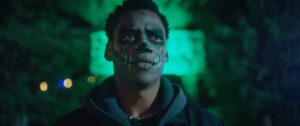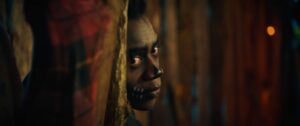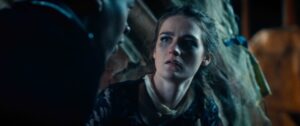A dream job for a horror-obsessed teen quickly unravels into a chilling nightmare.
The Haunted Forest (2025) plunges audiences into the world of scare actors, where staged frights bleed into real terror, and the boundary between performance and survival collapses. The film wastes no time establishing its tone, opening with a classic horror sequence before throwing viewers into a countdown to Halloween. What at first feels like a fun, eccentric workplace comedy for misfits soon becomes a paranoid thriller fueled by suspicion, sleepless nights, and the lingering specter of death.
Written and directed by Keith Boynton, the film plays like a love letter to both haunted attractions and the horror genre itself. Boynton balances macabre humor with twisting suspense, crafting a narrative that never lets up once the bodies start to fall. The script cleverly satirizes horror fandom and Halloween culture while steadily increasing the stakes, ensuring that every laugh is followed by unease. Tonally, the film evokes early 2000s horror with its blend of teenage energy, urban legend vibes, and bursts of paranoia, but with the added sheen of self-awareness.
Leading the film is Grayson Gwaze as Zach, a high school senior whose love of all things Halloween drives both his enthusiasm and his downfall. Wide-eyed, naïve, and brimming with energy, Gwaze captures the restless mix of excitement and exhaustion that comes with teenage obsession. His performance grounds the chaos in emotional authenticity, making Zach easy to root for even as he becomes consumed by nightmares, sleep deprivation, and an unsettling devotion to the macabre. It is refreshing to see a Black actor not only lead the film but survive long enough to take command of the story, breaking a tired genre trope. Opposite him is Cedric Gegel as Mark, the owner of the attraction and Zach’s cousin, whose vision for the Haunted Forest is both inspiring and dangerously uncompromising. Mark is determined to maintain the Forest’s reputation as one of the best haunts in the country, but as tragedy strikes, his priority shifts from the safety of his actors to preserving the brand. Gegel plays him as pragmatic to the point of coldness, offering a counterweight to Zach’s idealism.
Visually, The Haunted Forest thrives on atmosphere. The night sequences stand out, drenched in the colors of Halloween, deep oranges, harsh purples, and eerie shadows that turn the Forest into a twisted carnival of fear. The film leans into dreamlike sequences, blurring the line between Zach’s reality and his sleepless hallucinations. These choices reinforce the film’s themes of obsession and paranoia, creating a world that is as fun as it is unnerving. Thematically, the film explores what happens when fascination with death and horror collides with real tragedy. A seasonal job for misfits seeking camaraderie becomes a harrowing meditation on tradition, responsibility, and the price of devotion to the macabre. While the film delivers as a scare-fest filled with slashers, humor, and thrills, it also quietly asks its audience to consider what happens when the fun of horror crosses into real life, and when the adults meant to provide safety fail the young people who depend on them.
The Haunted Forest is not just about masked killers and staged scares. It is about community, obsession, and the fine line between embracing darkness and being consumed by it. Bloody, humorous, and undeniably engaging, it delivers both on its promise of scares and its deeper exploration of what it means to live for horror. And for those who think working at a haunted house would be the perfect Halloween gig, the film leaves a lingering question: are you sure you want the job?



